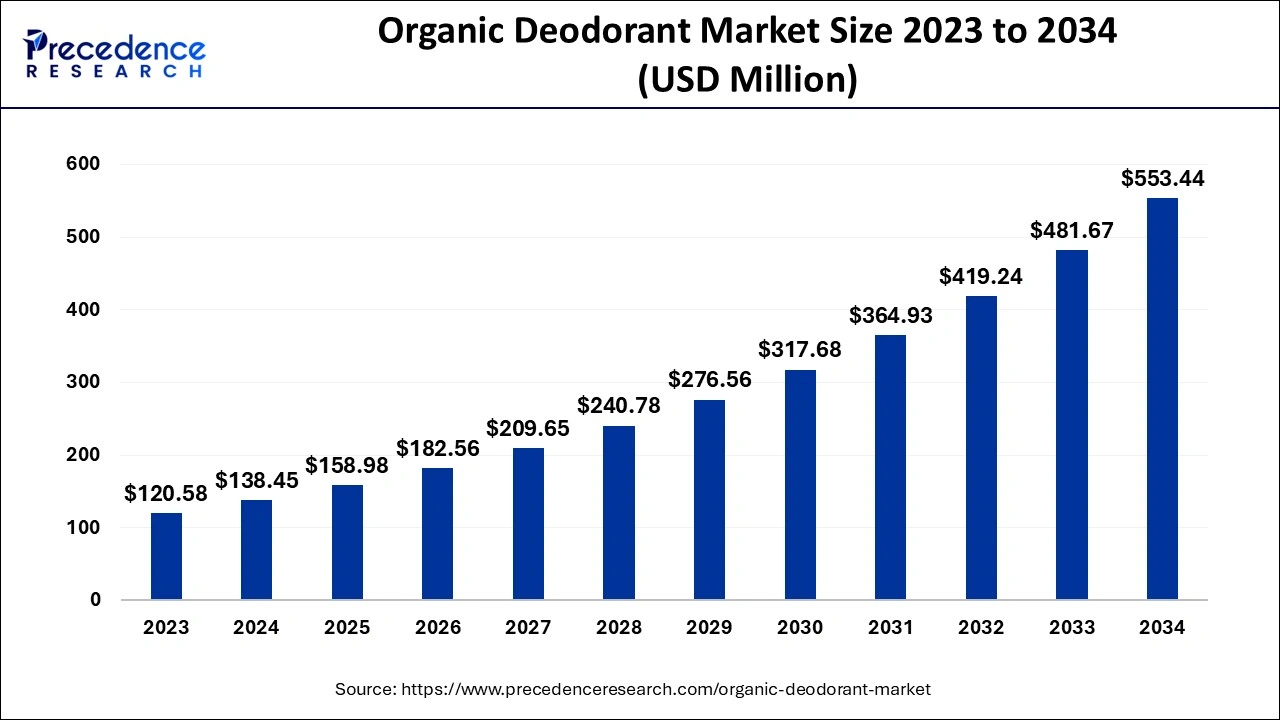
Organic Deodorant Market Key Takeaways
- Europe dominated the global market with the largest market share of 35% in 2023.
- Asia Pacific is anticipated to grow at the fastest CAGR of 15.53% during the forecast period.
- By type, the spray segment contributed the highest market share of 49% in 2023.
- By type, the stick/cream segment is projected to grow at a significant CAGR during the forecast period.
- By distribution, the supermarket/hypermarket segment captured the biggest market share in 2023.
- By distribution, the online segment is expected to grow at a solid CAGR during the forecast period.
Organic Deodorant Market Overview
The organic deodorant market categorized by product type includes stick, cream, spray, and roll-on deodorants. These variants cater to a growing consumer base that seeks natural, chemical-free alternatives to traditional antiperspirants. Organic deodorants differ from conventional options primarily by avoiding synthetic fragrances, parabens, aluminum compounds, and other harsh chemicals. Instead, they use plant-based ingredients such as coconut oil, baking soda, shea butter, and essential oils for odor control and skin nourishment.
As awareness regarding skin health, environmental sustainability, and ethical consumerism continues to rise, consumers are increasingly shifting toward organic deodorant products, driving robust growth across all product types. Stick deodorants currently dominate due to their convenience and familiarity, though creams and sprays are gaining popularity among specific user groups.
Organic Deodorant Market Drivers
The primary driver in this segment is heightened awareness of the potential health risks associated with synthetic deodorants, including concerns around hormonal disruption, allergic reactions, and links to breast cancer due to aluminum salts. Consumers, especially women, are actively seeking safer, more natural personal care alternatives.
The rising popularity of the clean beauty movement and the influence of social media influencers advocating for chemical-free products have also contributed to growing adoption. Additionally, organic deodorants often come in environmentally friendly packaging, aligning with the values of eco-conscious buyers. Increased availability and variety of product formats allow consumers to choose the type that best suits their lifestyle and preferences.
Organic Deodorant Market Opportunities
As consumers demand greater transparency, there is a significant opportunity for brands to innovate with new product formulations using locally sourced, sustainable ingredients. Organic spray deodorants, for example, offer an alternative for individuals who prefer touch-free application.
Cream-based products can be formulated for ultra-sensitive skin or infused with therapeutic essential oils, appealing to wellness-conscious users. There is also potential in creating hybrid products that combine the benefits of deodorants with skincare features like moisturizing or soothing properties. Customized and gender-neutral offerings could capture niche markets, providing brands with a competitive edge.
Organic Deodorant Market Challenges
Despite growing demand, organic deodorant products face challenges in terms of performance perception. Many consumers still doubt whether natural ingredients can offer the same level of odor protection and longevity as conventional antiperspirants. Ingredient stability, product shelf-life, and texture consistency can also be problematic, particularly in cream and spray formulations.
Another challenge lies in educating consumers on the detox transition period, during which users may experience increased odor as the body adjusts to chemical-free products. Balancing efficacy, scent, and skin sensitivity remains a key hurdle for manufacturers.
Organic Deodorant Market Regional Insights
North America leads the product type segment due to the widespread presence of organic and natural personal care brands, along with an educated and health-conscious consumer base. Europe follows closely, with demand rising in countries such as Germany, the UK, and France.
In the Asia-Pacific region, increasing urbanization and lifestyle shifts are contributing to the growing interest in organic products, especially among the younger generation. Latin America and the Middle East & Africa are emerging markets where local production and marketing of natural ingredients like shea butter and aloe vera offer strong potential.
Organic Deodorant Market Recent Developments
Product innovation in this segment has seen the launch of zero-waste stick deodorants packaged in biodegradable containers and cream deodorants in recyclable glass jars. Major natural beauty brands are expanding their product lines to include multi-scent and unscented options for consumers with allergies or scent sensitivities.
Furthermore, technological advancements in natural preservation methods are enabling longer shelf-life for organic deodorants without synthetic preservatives.
Organic Deodorant Market Companies
- PiperWai
- AKT London
- Salt of the Earth
- Salt & Stone
- Kosas Cosmetics
- Kopari Beauty
- Glossier
- Megababe Beauty
- Vichy laboratories
- Nécessaire
- Aesop
- Native Cosmetics
Segments Covered in the Report
By Type
- Roll-Ons
- Stick/Cream
- Sprays
By Distribution
- Supermarkets/Hypermarkets
- Convenience Stores
- Online
By Geography
- North America
- Asia Pacific
- Europe
- Latin America
- Middle East and Africa
Ready for more? Dive into the full experience on our website!
